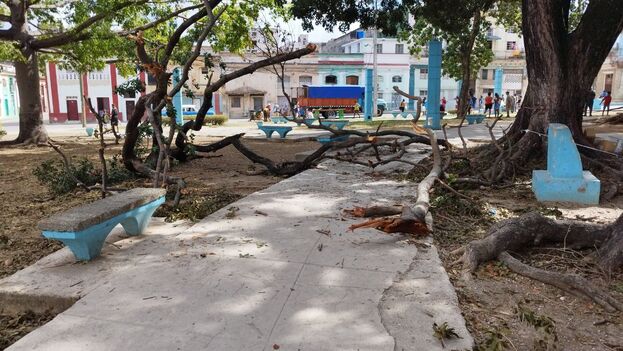
![]() 14ymedio, Juan Diego Rodríguez, Havana, 17 November 2022 — Although Hurricane Ian crossed Cuba seven weeks ago, the neighbors of Cayo Hueso, in Havana, have already become accustomed to the collapses and walls stained by moisture. The gritty and grimy buildings, in addition to the potholes in the streets, were part of the landscape long before the hurricane. But now, in addition, they have to live with the huge branches that the wind ripped off the trees in Trillo park.
14ymedio, Juan Diego Rodríguez, Havana, 17 November 2022 — Although Hurricane Ian crossed Cuba seven weeks ago, the neighbors of Cayo Hueso, in Havana, have already become accustomed to the collapses and walls stained by moisture. The gritty and grimy buildings, in addition to the potholes in the streets, were part of the landscape long before the hurricane. But now, in addition, they have to live with the huge branches that the wind ripped off the trees in Trillo park.
To get from one street to another you have to go around the poorly paved sidewalks, where the banks and other buildings are also neglected. No workers from the Communal Service, the firefighters or the Armed Forces — whose support after the hurricane was proclaimed by the official press — have cleared the impassible sections of the street.
“In this neighborhood the residents lament that everyone has gone to “see the volcanos” — using a phrase that implies emigrating via Nicaragua. When an old cargo truck appears people quickly crowd onto one of the streets that surround the park. The vehicle travels every week from Villa Clara and exhibits its merchandise — it’s not known if with permission or secretly — of meat, fruits and vegetables.
“Pineapples, for example, cost me 100 pesos in the San Rafael market, which has become impossible,” complains one of the women who waits her turn in line. “But at the truck I buy them at 25. They are smaller, but they’re not bad.”
Sitting on the curb at Trillo park, trying to dodge the dirt and desolation, the inhabitants of Cayo Hueso put their hope of being able to buy from the truck the food they need for the week.
A pound of malanga — “which is softened,” clarifies the seller — or guavas costs only 30 pesos; a pot of chili, 40, and beans — black or colored — can be had for 140. Compared to the prices of the capital, a pound of rice at 55 pesos is cheap, although a bunch of onions costs 80, and a bulb of garlic doesn’t fall below 400 pesos.
The ruin of public areas after Ian’s passage is not exclusive to Cayo Hueso. Throughout Havana one can see trees torn up by their roots, broken branches, leaf litter and property that no one will clean.
In the vicinity of the so-called “twenty plants” of Centro Habana, at Zanja and Hospital streets, the neighbors not only have to fence their houses to protect themselves from robberies and growing violence on the Island, they also now contemplate, from the balconies, an old broken tree trunk that, as if that weren’t enough, also destroyed the pavement.
Translated by Regina Anavy
____________
COLLABORATE WITH OUR WORK: The 14ymedio team is committed to practicing serious journalism that reflects Cuba’s reality in all its depth. Thank you for joining us on this long journey. We invite you to continue supporting us by becoming a member of 14ymedio now. Together we can continue transforming journalism in Cuba.
